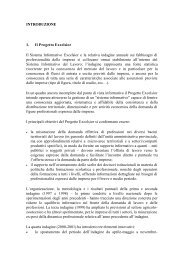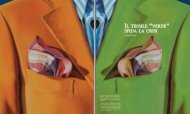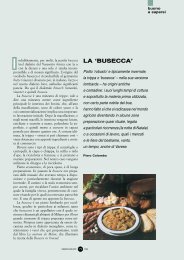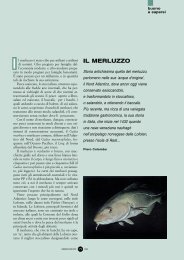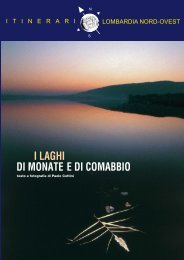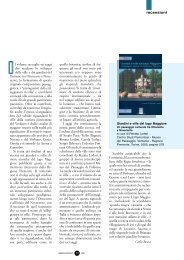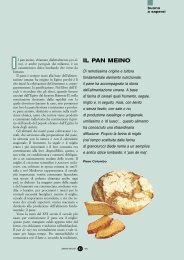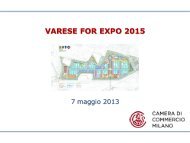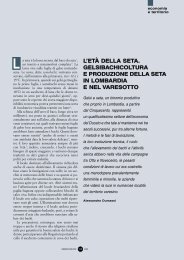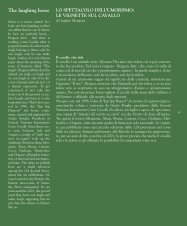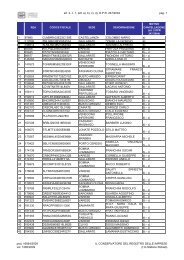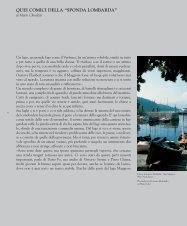i bei negozi: una tradizione che guarda al futuro - CCIAA di Varese
i bei negozi: una tradizione che guarda al futuro - CCIAA di Varese
i bei negozi: una tradizione che guarda al futuro - CCIAA di Varese
Create successful ePaper yourself
Turn your PDF publications into a flip-book with our unique Google optimized e-Paper software.
44<br />
I BEI NEGOZI:<br />
UNA TRADIZIONE CHE GUARDA AL FUTURO<br />
<strong>di</strong> Mario Chiodetti<br />
È il caffè dei giorni <strong>di</strong> pioggia, c<strong>al</strong>do come il ventre materno o l’abbraccio <strong>di</strong> un<br />
amico, con i minuscoli tavolini in marmo, le piccole se<strong>di</strong>e <strong>di</strong> legno e il profumo<br />
delle paste e dei cappuccini a girare nell’aria come un pensiero <strong>di</strong> felicità.<br />
Il “Ghezzi” sta lì d<strong>al</strong> 1919, in corso Matteotti 36, poco più avanti <strong>di</strong> un’<strong>al</strong>tra<br />
vecchietta arzilla, la gioielleria, o meglio “giojelleria”, come si legge nell’insegna,<br />
Buzzetti, aperta nel 1875 da Sebastiano e tuttora centro <strong>di</strong> raffinate proposte<br />
d’acquisto. Entrambi hanno ottenuto d<strong>al</strong>la Regione Lombar<strong>di</strong>a il riconoscimento<br />
<strong>di</strong> “Negozio storico <strong>di</strong> rilievo region<strong>al</strong>e”, <strong>una</strong> sorta <strong>di</strong> onorificenza<br />
assegnata a un esercizio <strong>che</strong> conserva nel tempo caratteristi<strong>che</strong> <strong>di</strong> eccellenza<br />
sotto il profilo storico, architettonico e cultur<strong>al</strong>e: come <strong>di</strong>re mantenersi fedeli<br />
a se stessi e <strong>al</strong>l’<strong>al</strong>ta qu<strong>al</strong>ità.<br />
Il caffè Ghezzi è un luogo <strong>di</strong> delizie oggi frequentato an<strong>che</strong> da parecchi giovani,<br />
<strong>che</strong> arrivano magari nel pomeriggio, dopo le lezioni universitarie, a bersi un<br />
tè <strong>al</strong>la frutta con <strong>una</strong> delle speci<strong>al</strong>ità dolciarie della casa.<br />
«I tre fratelli Ghezzi, Angelo il maggiore, Carlo e Fort<strong>una</strong>to, rilevarono la pasticceria<br />
Vanetti nel 1919 e <strong>di</strong>eci anni dopo, comperato lo stabile, ne rifecero l’arredo<br />
ampliando an<strong>che</strong> la s<strong>al</strong>a. I mobili <strong>che</strong> ci sono ancora oggi li costruì un artigiano<br />
<strong>di</strong> Cusano Milanino, Pietro V<strong>al</strong>sassina, provetto ebanista, prima <strong>di</strong> andare<br />
in pensione», racconta Giovanna Ghezzi, titolare della pasticceria, gestita con<br />
la cognata Maria Caterina Cerovaz, dopo la morte del fratello Martino, continuatore<br />
dell’arte dello zio Fort<strong>una</strong>to, il creativo <strong>di</strong> famiglia.<br />
Il loc<strong>al</strong>e mostra <strong>al</strong>tre bellezze d’antan, come i lampadari delle due vetrine, in<br />
origine a gas, pezzi da museo un tempo usati sui tram milanesi, o i due centr<strong>al</strong>i<br />
in crist<strong>al</strong>lo.<br />
«Quelli avanzarono da un or<strong>di</strong>nazione <strong>che</strong> il teatro <strong>al</strong>la Sc<strong>al</strong>a <strong>di</strong> Milano fece<br />
per il foyer, e mio zio se li accaparrò. Fort<strong>una</strong>to era un t<strong>al</strong>ento della pasticce-<br />
Nella competizione tra territori quello <strong>che</strong> è il centro storico delle nostre città<br />
ha un peso determinante, in termini <strong>di</strong> capacità d’attrazione <strong>di</strong> persone e<br />
risorse. E del centro storico i <strong>bei</strong> <strong>negozi</strong> sono un fattore decisivo. Occorre, però,<br />
<strong>che</strong> ce ne siano tanti...<br />
Alfredo Ambrosetti<br />
The nice shops: a tra<strong>di</strong>tion<br />
which does not forget the future<br />
It is the coffee bar where you can<br />
go when it rains. It is warm like a<br />
matern<strong>al</strong> belly or the hug of a<br />
friend. It is furnished with sm<strong>al</strong>l<br />
marble tables and sm<strong>al</strong>l wooden<br />
chairs. And the smell of cakes<br />
and cappuccinos transforms itself<br />
in a sweet and happy thought.<br />
This coffee bar is c<strong>al</strong>led Ghezzi<br />
and was opened in 1919, in the<br />
main street of <strong>Varese</strong>, that is<br />
Corso Matteotti no. 36. It lies just<br />
after an other lively old shop, that<br />
is the jeweller’s (or, as the sign<br />
says: “Giojelleria Buzzetti”). This<br />
jeweller’s shop was opened in<br />
1875 by Sebastiano and it still represents<br />
a centre of refined ideas of<br />
purchase. Both of them have been<br />
named by Lombardy Region “Negozio<br />
storico <strong>di</strong> rilievo region<strong>al</strong>e”<br />
(Historic<strong>al</strong> Shop with Region<strong>al</strong> Relevance).<br />
This honour is conferred<br />
upon a shop which has been keeping<br />
the excellence from a historic<strong>al</strong>,<br />
architectonic<strong>al</strong> and cultur<strong>al</strong><br />
point of view. In other words these<br />
shops stick to their own origins<br />
and are loy<strong>al</strong> to high qu<strong>al</strong>ity.<br />
The Ghezzi coffee bar is a sweet<br />
place, that nowadays is <strong>al</strong>so patronized<br />
by many young people.<br />
They usu<strong>al</strong>ly arrive in the afternoon<br />
after their lectures, to drink a<br />
fruit tea and eat one of the confectionery<br />
speci<strong>al</strong>ities of the house.<br />
The three Ghezzi brothers (Angelo,<br />
who is the oldest, Carlo and<br />
Fort<strong>una</strong>to) took over the Vanetti<br />
confectioner’s in 1919. After 10<br />
years they bought the buil<strong>di</strong>ng,<br />
renewed the furniture and en-<br />
larged the rooms. This furniture,<br />
which is still present, was created<br />
by a craftsman of Cusano Milanino,<br />
c<strong>al</strong>led Pietro V<strong>al</strong>sassina.<br />
«He was a skilled cabinet-maker<br />
and created it before to retire»,<br />
tells Giovanna Ghezzi, owner of<br />
the confectioner’s. Since the<br />
death of her brother Martino, she<br />
has been running the confectioner’s<br />
with her sister-in-law Caterina<br />
Cerovaz. Martino was the follower<br />
of the art of his uncle Fort<strong>una</strong>to,<br />
who was very creative.<br />
The coffee bar shows other beauties,<br />
such as the light fixtures of<br />
the two windows (which were<br />
origin<strong>al</strong>ly gaslights), museum<br />
pieces which were formerly used<br />
on the trams of Milan, as well as<br />
the two centr<strong>al</strong> cryst<strong>al</strong> chandeliers.<br />
“Those chandeliers were taken by my<br />
uncle from the Teatro della Sc<strong>al</strong>a,<br />
because they were left from an order<br />
that the theatre placed for the foyer.<br />
My uncle Fort<strong>una</strong>to was a t<strong>al</strong>ented<br />
confectioner. He invented our speci<strong>al</strong>ity,<br />
the sugar fondants. He created<br />
<strong>al</strong>most 300 plaster moulds, carving<br />
them manu<strong>al</strong>ly like sm<strong>al</strong>l sculptures”.<br />
Among our famous customers we<br />
mention Gabriele d’Annunzio, the<br />
gener<strong>al</strong> Luigi Cadorna, the Count<br />
Caproni, the journ<strong>al</strong>ists Luigi<br />
Barzini sr. and Luigi Albertini,<br />
Li<strong>al</strong>a, Guido Piovene and Guido<br />
Morselli, Alfredo Binda, the actors<br />
Gandusio, Ruggeri, Dina G<strong>al</strong>li,<br />
and Renato Guttuso, who arrived<br />
with his wife Mimise.<br />
A roy<strong>al</strong> jeweller’s shop<br />
King Faruk often bought at<br />
Enri<strong>che</strong>tta’s shop, which was a<br />
Il sapore dell’eleganza, l’eleganza del sapore nei <strong>negozi</strong> <strong>di</strong> Buzzetti, Ghezzi, Veniani, Borducan (fotografie <strong>di</strong> Mario Chiodetti)<br />
The pleasantness of polish and the refinement of the shops<br />
of Buzzetti, Ghezzi, Veniani, Borducan (photographs by Mario Chiodetti)<br />
In the competitions among lands, the old centre of our towns has a fundament<strong>al</strong><br />
weight in attracting people and resources. And the nice shops represent the decisive<br />
element of an old town centre. But it is necessary to have many shops…<br />
Alfredo Ambrosetti<br />
45
outique of fruits and vegetables<br />
during the Sixties. Then, he used<br />
to go at Buzzetti’s shop, where he<br />
person<strong>al</strong>ly chose the precious<br />
stones to give his roy<strong>al</strong> mistresses.<br />
Today, Remo and Luciana Buzzetti,<br />
helped by their son Luigi<br />
and by the daughter-in-law Letizia,<br />
still work in this wonderful<br />
shop with nineteenth-century<br />
furniture and frescoed vaults.<br />
The beauties outside the town<br />
Outside the town there are two<br />
other shops which gained the<br />
Region<strong>al</strong> approv<strong>al</strong>: Borducan<br />
(Sacro Monte) and Veniani confectioner’s<br />
of Gavirate, where in<br />
1878 the so-c<strong>al</strong>led Brutti e Buoni<br />
were invented. The coffee bar<br />
Borducan has an art nouveau<br />
décor and it <strong>al</strong>so represents a refined<br />
hotel. But above <strong>al</strong>l it represents<br />
the stage of a great actor,<br />
that is the elixir invented in 1872<br />
by the Garib<strong>al</strong><strong>di</strong>an Davide Bregonzio.<br />
This liqueur is prepared<br />
from oranges and sweet herbs and<br />
served in a speci<strong>al</strong> bottle with a<br />
carillon work. This coffee bar was<br />
opened in 1924 by Anita Angiolini<br />
Bregonzio. In 1947 she<br />
was succeeded by her son Bruno,<br />
who was immort<strong>al</strong>ized by Franco<br />
Pontiggia in a wonderful image<br />
on the cover of his book “Profumo<br />
<strong>di</strong> Provincia”. This elixir of<br />
the coffee bar Borducan obtained<br />
prestigious prizes for its qu<strong>al</strong>ity.<br />
The first one was the gold Med<strong>al</strong><br />
that Borducan received in 1924<br />
at the Rome trade fair, as the certificate<br />
hanged at the entrance of<br />
the coffee bar shows.<br />
In 1875 Costantino Veniani<br />
opened a confectioner’s, which<br />
has his same name. When Giosuè<br />
Carducci met his loved Annie<br />
Vivanti, he usu<strong>al</strong>ly went there.<br />
The loc<strong>al</strong> collection of anecdotes<br />
shows that <strong>al</strong>so Queen Elena used<br />
to stop in Gavirate when she<br />
returned from Milan and used to<br />
buy the typic<strong>al</strong> Veniani’s sweets<br />
with hazelnuts and whites of eggs<br />
beaten stiff. An other fond customer<br />
was Giuseppe Ver<strong>di</strong>, who<br />
I portici ti accompagnano nello shopping nel Corso Matteotti a <strong>Varese</strong> (fotografia <strong>di</strong> Paolo Zanzi)<br />
Archades <strong>al</strong>ong Corso Matteotti in <strong>Varese</strong> (photograph by Paolo Zanzi)<br />
ria, fu lui a inventare la nostra speci<strong>al</strong>ità, i fondants <strong>di</strong> zuc<strong>che</strong>ro. Creò quasi<br />
300 stampi in gesso, intagliandoli a mano uno per uno come piccole sculture».<br />
Tra i clienti illustri ricor<strong>di</strong>amo Gabriele d’Annunzio, il gener<strong>al</strong>e Luigi Cadorna,<br />
il conte Caproni, i giorn<strong>al</strong>isti Luigi Barzini sr. e Luigi Albertini, Li<strong>al</strong>a,<br />
Guido Piovene e Guido Morselli, Alfredo Binda, gli attori Gandusio, Ruggeri,<br />
Dina G<strong>al</strong>li, e Renato Guttuso, <strong>che</strong> arrivava con la moglie Mimise.<br />
Un gioielleria reg<strong>al</strong>e<br />
Da Buzzetti, invece, passava spesso re Faruk, <strong>che</strong> dopo aver fatto spesa da<br />
Enri<strong>che</strong>tta, <strong>una</strong> sorta <strong>di</strong> “boutique della frutta e verdura” degli anni Sessanta,<br />
sceglieva person<strong>al</strong>mente le gemme da donare <strong>al</strong>le sue favorite. Oggi, nello<br />
splen<strong>di</strong>do <strong>negozi</strong>o dai mobili ottocenteschi e d<strong>al</strong>le volte affrescate, lavorano<br />
ancora Remo e Luciana Buzzetti, aiutati d<strong>al</strong> figlio Luigi e d<strong>al</strong>la nuora Letizia.<br />
Il bello “fuori porta”<br />
Uscendo fuori porta, <strong>al</strong>tri due loc<strong>al</strong>i si sono meritati il plauso region<strong>al</strong>e: il<br />
Borducan del Sacro Monte e la pasticceria Veniani <strong>di</strong> Gavirate, dove nacquero,<br />
nel 1878, i “Brutti e buoni”. Con il suo décor art nouveau, il Caffè del<br />
Borducan, oggi an<strong>che</strong> <strong>al</strong>bergo raffinato, è il suggestivo p<strong>al</strong>coscenico per la recita<br />
del grande attore, l’elixir inventato nel 1872 d<strong>al</strong> garib<strong>al</strong><strong>di</strong>no Davide Bregonzio,<br />
un liquore a base <strong>di</strong> arance ed erbe aromati<strong>che</strong> servito da un contenitore<br />
con meccanismo a carillon. Il loc<strong>al</strong>e sacromontino nacque nel 1924 per<br />
merito <strong>di</strong> Anita Angiolini Bregonzio, cui succederà, nel 1947, il figlio Bruno,<br />
immort<strong>al</strong>ato da Franco Pontiggia in <strong>una</strong> splen<strong>di</strong>da immagine in copertina <strong>al</strong><br />
suo libro “Profumo <strong>di</strong> provincia”. L’elixir <strong>al</strong> Borducan ha ottenuto nel corso<br />
degli anni prestigiosi riconoscimenti <strong>di</strong> qu<strong>al</strong>ità, a partire d<strong>al</strong>la Medaglia d’oro<br />
47
48<br />
<strong>al</strong>la Campionaria <strong>di</strong> Roma del 1924, come certifica l’attestato appeso <strong>al</strong>l’ingresso<br />
del caffè.<br />
Da Costantino Veniani, fondatore nel 1875 dell’omonima pasticceria, passava<br />
Giosué Carducci in visita <strong>al</strong>l’amata Annie Vivanti, vuole l’aneddotica <strong>che</strong><br />
an<strong>che</strong> la regina Elena <strong>di</strong> ritorno da Milano sostasse a Gavirate per un rifornimento<br />
dei dolcetti <strong>al</strong>la nocciola e bianco d’uovo montato a neve, mentre un<br />
cliente affezionato era Giuseppe Ver<strong>di</strong>, cui il pasticcere de<strong>di</strong>cò <strong>una</strong> torta vincitrice<br />
<strong>di</strong> Medaglia d’oro <strong>al</strong>l’Esposizione varesina del 1901.<br />
Frustoli <strong>di</strong> storia, segni piccoli e gran<strong>di</strong> della cultura impren<strong>di</strong>tori<strong>al</strong>e del<br />
Varesotto, <strong>che</strong> unita <strong>al</strong>la creatività dà frutti capaci <strong>di</strong> sfidare il tempo e <strong>di</strong>ventare<br />
parte stessa del nostro quoti<strong>di</strong>ano immaginario.<br />
was de<strong>di</strong>cated a cake by Veniani’s<br />
confectioner’s shop. This cake<br />
won the gold Med<strong>al</strong> of the Fair of<br />
<strong>Varese</strong> in 1901. Historic<strong>al</strong> anecdotes,<br />
big or little signs of the<br />
entrepreneuri<strong>al</strong> culture of the<br />
Province of <strong>Varese</strong>. This culture<br />
and the inventiveness bear fruits<br />
which are able to defy time and<br />
become part of our daily fantasy.<br />
49



